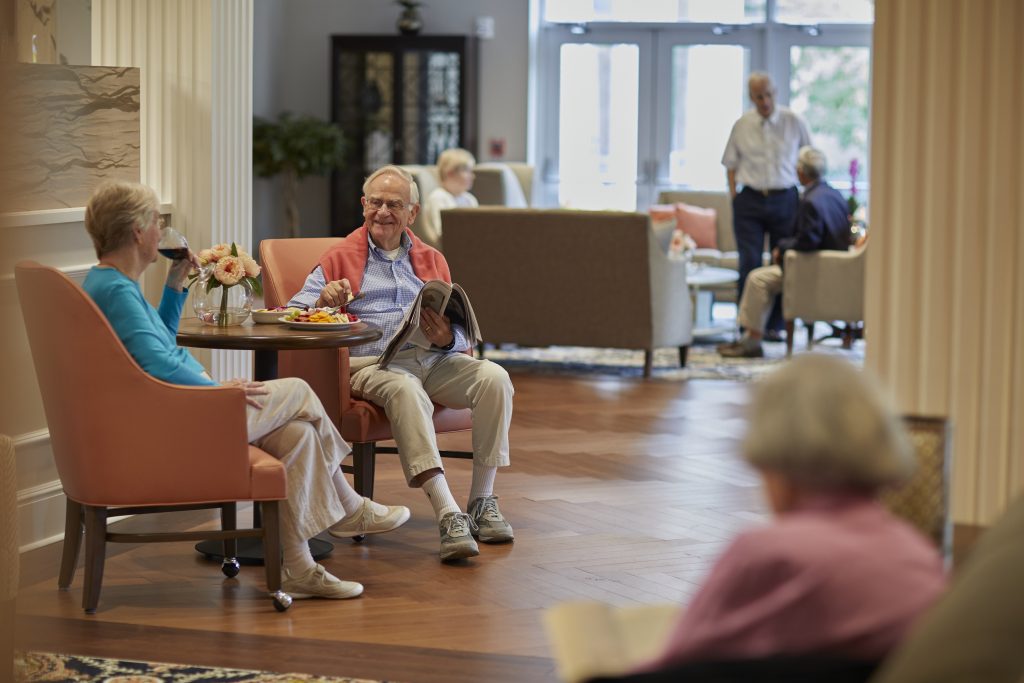Designing Safer Spaces for Senior Living Communities

Over the past three months, senior living communities across the country have weathered unprecedented conditions due to the Covid-19 pandemic. As elderly residents are highly susceptible to the coronavirus disease due to age and underlying conditions, these communities must swiftly adapt as they look to the future of providing care in a post-Covid world.
As designers, we have the ability to assist in these adaptations through design solutions that create a safer environment and deter contamination from infectious diseases. Driven by economic factors and the need to foster socialization within these communities, residents are often placed in close quarters which can further the spread of infectious diseases. The design of private rooms, common areas, and outdoor spaces can all be adjusted to create a healthier environment.
Adjustments to these living arrangements are assessed constantly – Bernardon maintains a conscious effort to implement thoughtful, customized design solutions within each of our senior living projects – and now more than ever, our designers are committed to enhancing that approach in light of Covid-19. Below are design adaptations Bernardon designers recommend when considering updating a senior living community in response to a pandemic:
Create Spaces for Quarantine
While not always ideal, quarantining has proven to be an effective measure against infectious diseases such as coronavirus. However, it’s important to remember that quarantine does not always have to equate to strict isolation. Incorporating different types of groupings – from private rooms to “neighborhoods” within a unit – offers a variety of livable spaces for residents to use, and also temporarily isolate when needed. The design should be flexible enough to create these groupings for all residents; and, can be part of a larger scope throughout the facility and divided when necessary. We suggest considering the following options:
- Private Rooms – Provides the opportunity for all healthcare residents to isolate when needed, and is necessary for any quarantine situation when the community will need to find space for transferring well residents away from ill residents.
- One-Bedroom Apartments – Provides a way for couples to isolate together within a unit.
- Neighborhoods – Create groups of units or rooms in limited numbers to develop neighborhoods which can be isolated from the community when needed to stop the spread of disease.
- Mechanical Systems – Provide a way to isolate air flow within the neighborhoods and units.
Design Common Areas that Limit Interaction
In addition to quarantining, limiting interactions with others – again, not always desirable – has proven to be another effective defense against widespread infectious disease. Providing socialization for residents remains a priority within senior living communities as it improves both overall health and quality of life. However, common areas often create opportunities for contamination, so it’s important to address how elements of these areas can be designed to respond to a potential outbreak:
- Services – Address how services such as food delivery, linen changes, housekeeping, and caregiving can be provided with minimal interaction with staff to deter the spread of disease.
- Common Areas – Provide intimate common areas within the neighborhoods that allow for both socialization and social distancing.
- Outdoor Areas – Create space that’s accessible from each living unit for fresh air and sunlight during times of isolation.
Implement Surfaces that Can be Easily Cleaned
Following the Covid-19 outbreak, studies were conducted on the transmitting virus, known as SARS-CoV-2. One study focused on how long SARS-CoV-2 can last on surfaces ranging from plastic to stainless steel to wood. According to Healthline.com, the studies reported that the virus can last on these various surfaces from 24 hours up to 7 days. While surfaces can’t simply be eliminated, we suggest incorporating surfaces and adaptations that promote easy cleaning:
- Surfaces – Incorporate surfaces which can be easily cleaned and often without damage to the finish.
- Out-of-Reach Areas – Limit out-of-reach horizontal surfaces which can harbor dust and germs.
- Proper Cleaning – Include cleaning areas in the building design where mobile carts can be periodically cleaned to limit the spread of germs.
Design to Enhance Personal Protection
When it comes to responsive design in the wake of an outbreak, creating space sometimes isn’t always enough. Personal protective equipment (PPE) is a vital need, and while we as designers can’t provide the physical PPE necessary, we can create environments that support its use and effectiveness. Equipping communities with these measures will ensure the safety of both staff and residents:
- Entryway Assessments – Design areas for gathering health assessment information at entry points.
- PPE Stations – Create Personal Protection Equipment stations for staff to use; these stations should be easily accessible so that they can be refilled in a timely manner.
- Handwashing Stations – Position hand washing/hand sanitation stations within the neighborhood for staff.
Incorporate Technology into the Design
To reinforce the effectiveness of the design approaches mentioned above, we suggest incorporating technology to enhance communication between staff and residents. To abet the unpredictability of rapidly spreading infectious disease, telecommunications can serve as a vital part to the design:
- Telehealth – Investigate possible telehealth connections throughout the community to improve general information and specific consultation within the resident unit.
- Installation – Utilize spare routing and power sources for installation of telehealth equipment.
At the early stages of designing a senior living community, considering these approaches – especially in response to a widespread pandemic – will help foster a safer environment for both the residents and staff. Incorporating responsive design while still creating a residential environment that feels like home might just be the best design defense for senior living communities. No matter how much isolation infectious disease prevention may require, coming together to create a safe and healthy environment will help to provide seniors with a comfortable, engaging living community to enjoy.
If you’re interested in discussing solutions for your senior living community, contact one of our designers here.
< Return to Blog